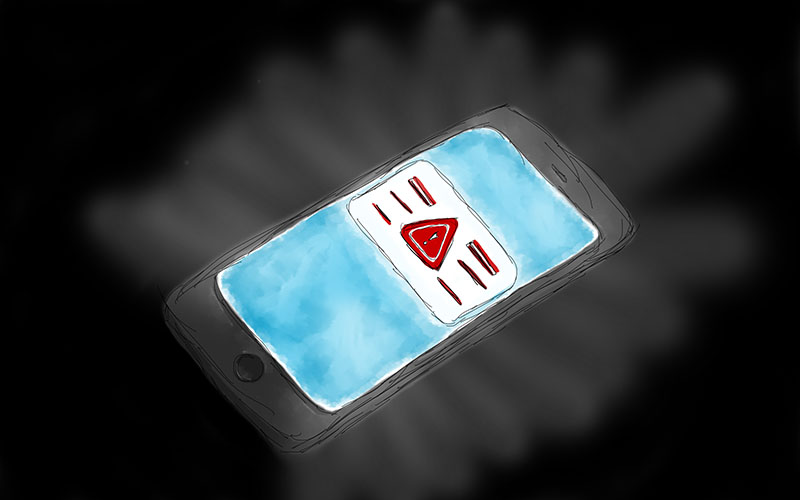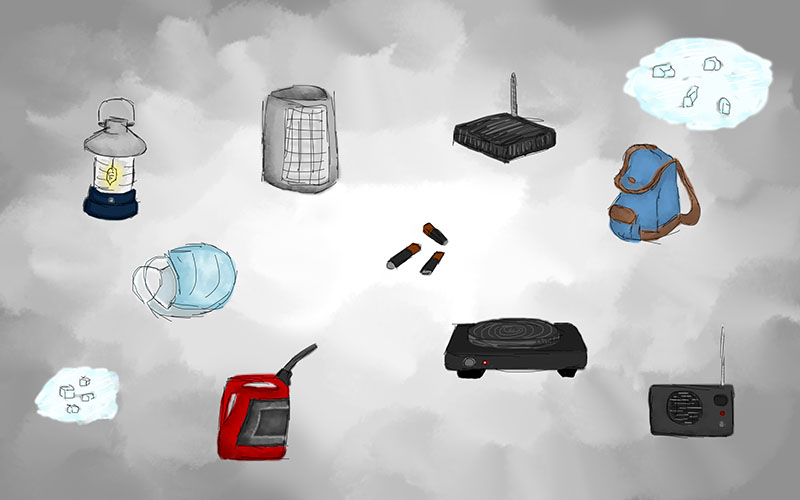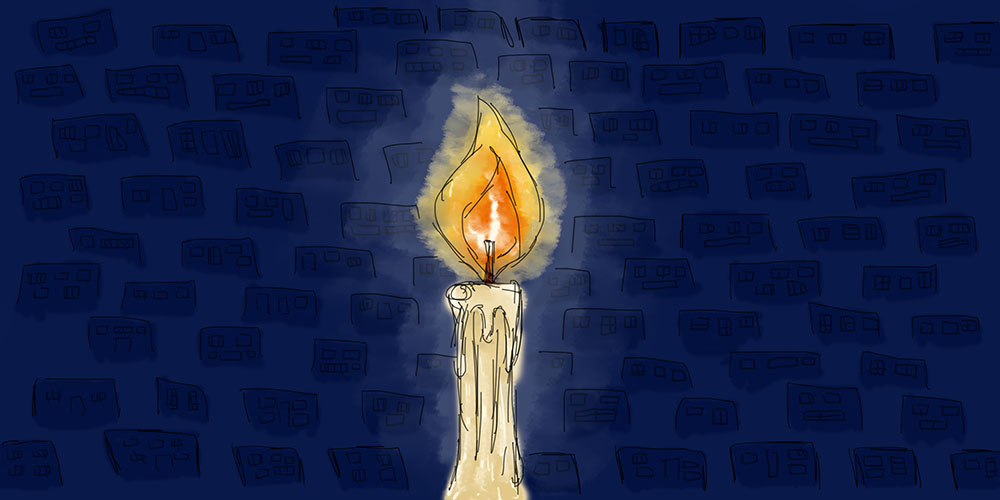We dangle our forearms over the wooden railing, gazing down the hillside at the darkness. “Look, someone over there has power,” my son Emmet points at a far-off flicker. “Yeah, maybe,” says my husband. “Huh. It could just be a candle,” Emmet amends. “It’s not very bright.” A couple of rumbling generators, unseen, but clearly not far away, overlay the quiet.
It’s day two of the second power outage in our Oakland hills neighborhood this October, and we’re eagerly scouting for neighborhoods near us that are being powered back up, faithfully tending to our hope that we’ll be next. Ah, did I say power outage? I mean “public safety power shutoff,” which we’ve been told by our electric utility provider, PG&E, is for our own good.
A little bit of background: Pacific, Gas & Electric (PG&E), provides power to most of northern California. Its equipment (which is badly in need of maintenance) was found to be liable for causing the 2018 Camp Fire, the worst fire in modern California history, in addition to multiple devastating fires in Mendocino and wine country the year before. PG&E turned off power twice to our home in October 2019 and up to five times in other regions of northern California during recent periods of critical fire risk.
Communication from PG&E at the beginning of the month read something like this: Critical fire weather is forecast over the next week, including high winds and low humidity. In order to ensure your safety, please prepare for up to six days without power. But it might not last that long. Or at all. Your local school may be closed. But it might not. Refer to our website for additional information (which, when investigated, announces an error due to unexpectedly high traffic). Keep phones charged (for 6 days?) in order to receive any emergency alerts (from cell towers that won’t have power?). After these head-scratchers, we heard nothing for quite a while. Finally, we received a text alert telling us that if power wasn’t off already, it would be shut off imminently. Which turned out to be 11 hours later.

This communication, which I’ll venture isn’t outlined in any business best practice guide, has rendered PG&E only marginally more popular than a turd in the punch bowl. If forced to choose just one piece of communication to illustrate this point, I’d probably select the press release PG&E issued requesting that California residents refrain from attacking its employees, as “several have been shot at.” In one instance, a PG&E-marked truck, driven by an employee, was hit multiple times by a rifle on the interstate in one of the more gun-toting counties (yes, they do exist) in central California.
In a grateful nod to the importance of local governance, many city and county resources stepped in to fill the communication void. The police department in Pleasanton, a town about 20 miles southwest of San Francisco, issued these helpful (satirical) guidelines in a Facebook post:
If you come home and everything is dark and nothing works, then yes, you are experiencing a power shutdown. Remain calm. Use your cell phone light to search frantically for the one flashlight you think you have in the house. It will be dead of course. Search for batteries. You will need four but only find three.
Keep your freezer and refrigerator doors closed to keep food from spoiling. If you have teenagers this may be difficult so speak loudly but slowly to them so they understand. You may need to hang a sign on the doors as well. Use big letters.
Given that we inherited a clunky, early-generation solar system with a battery backup when we moved into our home, we anticipated that we’d be mostly okay, with the exception of our stove and oven, which for some bizarre reason, don’t seem to be connected to the battery. We learned shortly after the first outage, though, that when a neighborhood is powered down, so are most local cell towers and neighborhood internet hubs, which leaves residents almost entirely disconnected from the outside world. As one NextDoor user mused, “If we don’t have internet and phone, how will be notified if we need to evacuate because of, say, a fire?” That scenario is not entirely unlikely, given that the power is out because of high fire danger. In an unsettling confirmation of the conditions, many fires started in the greater bay area during those days, sending wailing sirens out and plumes of brown smoke in.
The prep list I developed after the first outage reads uncannily like a to-do list for, say, an extended camping trip on an active volcano:
- breathing masks ready
- go bags packed
- shower beforehand (no power = abysmal water pressure)
- camping stove
- portable air filters prepped
- cell signal booster ready
- park ready to leave: one street over, a tank full of gas
- and once the battery backup is depleted: battery-powered lamps, freezer and a cooler filled with ice, and a battery-powered radio

In an information blackout, those who do provide it become our best friends in short order. Due to the patchy-to-nonexistent cell service, my phone never actually rings. But whenever a message happens to filter through the ether and notify my device, I’m overjoyed. One of my favorites is from my son’s school district. “Hello OUSD families. This is communications director John Sazaki, calling with an update.” His voice is booming, cheerful. Wow, someone knows something and he’s communicating it to us! I never knew our school district had a communications director, much less what his name was, but no matter. He’d tell us in his friendly voice, that school would be closed tomorrow, administrators would await word from the district or that we should anticipate a closure through Thursday. But even he, perhaps in acknowledgment of the collective fatigue that had begun to penetrate the community, began adding, “Thank you for your patience during this trying time,” as the days of uncertainty piled up. Still cheerful, but with a note of resignation, even pique.
Indeed, most public-facing services during this time acquired an air of the superlative. PG&E was the absolute worst. The neighborhood grocery store, which brought in a massive generator to keep it up and running, was the most awesome thing we’d ever encountered. Comcast, with no battery backups in its neighborhood hubs, was obviously woefully delinquent. Twitter, with its specific updates from previously obscure individuals (the county sheriff, for example), was a lifeline.
With a dearth of information about nearby incidents, including fires, we became smoke readers, sharing our observations with clumps of neighbors gathering next to the generator in the grocery store parking lot. We’d watch the sky, the smoke streaming in from different directions, and analyze the threat. Does it smell strongly? Can you hear sirens? Where’s it coming from? One town over? Across the bridge? How much smoke? Is there more or less of it over time? What color is it, brown (burning new fuels), or white (mostly steam, and thus likely close to being put out)?
We joke, but this is the sort of scenario that will only become more frequent in the future, though I’d rather toss the phrase “new normal” out the window into the darkness it engenders. Combine a changing climate, hordes of people, and outdated infrastructure and we find ourselves aboard the slow-motion train wreck that is fire season in California.
We’ve assumed for decades, compounded in recent years, that we have access to information, that we can know things — that is, if we want to. It’s disconcerting to discover how whisper-thin our layer of knowledge is, how utterly dependent we are on things we can’t directly control: internet, electricity, weather.
Later in the evening, we again venture to our back deck, and watch as sector by sector, the hillside is powered back up. We scrutinize the sky, the smoke spilling in from a new fire in the north, and know that both the hazards and horrors are very real. We watch and wonder: What’s it like up there? What are your stories? •




